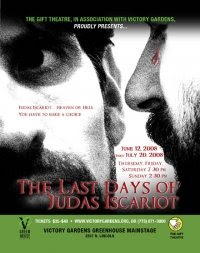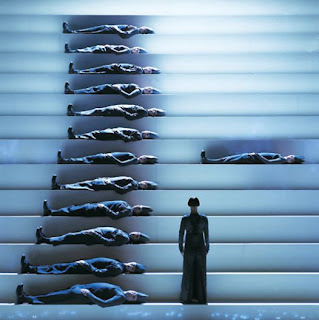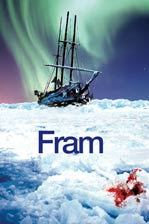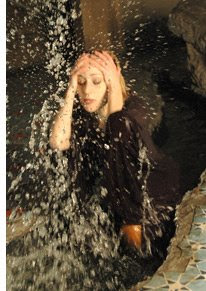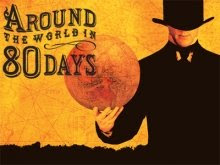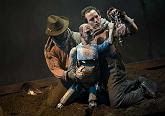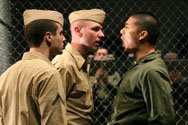I'm at the Theatre Communications Group conference, where yesterday everyone was talking about this show. They were either excited to see it, resentful of it, or resentful of it but still interested in seeing it. Some thought the show might make them angry but I thought it sounded insular, and thus, wasn't terribly interested in seeing it. With all thet alk, though, I couldn't resist.
"How Theater Failed America" is a monologue, with Mike Daisey sitting at a desk on a bare stage, with very minimal lighting, talking into the full but dark auditorium. It's an incredibly funny critique of the current state of American theaters but a critique that comes out of an intense love of theater and its possibilites for transforming lives. He opens the piece by speaking directly to the audience and saying: I wonder why you've come. The implication is that he has nothing positive to say to this theater-going crowd about theater and so it's surprising that they'd show up to hear it. He list a few hysterical reasons why he's surprised folks would come to see the show and then gives a few hysterical reaons why they might have. Perhaps we want to hear him place blame, he says. Perhaps we want to hear him talk about how the young people have short attention spans, with iPods always in their ears; how funders have screwed things up; how critics, especially thet "NY Times" and Charles Isherwood, have ruined things for theater. It's a sly parody of the reasons arts administrators give for the state of the arts. The audience is good natured, though, and they laugh at themselves throughout this. Then Daisey changes his cadence and begins to speak very slowly and says "It's not the NEA, or corporate funders, or short attention spans, it's not evern Charles Isherwood that's ruined theater, it's you [long pause] and it's me." What had been 5 or 10 minutes of good fun turns very serious and just as the tenstion becomes too much to bear, he turns the page of his notes and cuts then tension.
This moment is indicative of the piece. It uses humor to challenge the audience, at times it's accusations are serious and direct, and it uses the conventions of the monologue (and to a lesser extent theater more broadly) to structure the piece but also to make the tone work. He wants to challenge the audience but he doesn't want to alienate them.
He walks the audience though a series of stories that are in turn funny and poignant. They speak to the power of theater and the ways it can provide hope for its participants and the ways in which theater companies, the artists and administrators, have sold out the theater. I'll tell one story quickly. He tells about a production of Genet's "The Balcony" in which he played the cardinal. The direction said he wanted to create a "super fucked up" production and does so. He put the actors in boots that are a foot-and-a-half off the ground, has them wear outrageous wigs and thick kabuki make-up, and has a dwarf and mud wrestling. What it didn't have, Daisey tells us, was sound dramaturgy.
When the director tells Daisey, who is a pretty fat guy, that after his speech four minutes into the play he should open his cardinal's robe and beat off, Daisey is torn. One side tells him that actors do what directors tell them to do but the other side knows this has gone too far. When he tells the director that his masturbating on stage is needless and doesn't contribute to the ideas in the play, the director replies that that is why it is "super fucked up." Daisey, being an actor, follows his director's instructions and comes up with the most fucked up way of masturbating he could imagine. After a late seating one night when a young girl enters the small theater right at the moment of his perverse masturbation scene, he wonders if he should do it. He hestitates for a while and then he does. As he readies himself in that moment to begin masturbating, he tells himself that he's an actor and he's doing what actors do. But then he can't sleep for nights. He loses sleep, not because he masturbated in front of a child, but because, as an actor, he couldn't think of what else to do.
Daisey presents a number of such stories, each bringing a different point to light. That one makes plain the danger that artists, despite their reservations, sometimes give over too much control to their collaborators. Another story illustrates the point that in our mad rush to build new buildings for our theaters, generating enough revenue to fill these large houses takes us away from our original impulses for creating theater and fiorces us to put on safe productions that do not feed our artists passion. We become a business, a corporation, and not a place where artists work together as a community. Corporations, he reminds us, can't love the theater, only individuals can love the theater. An artistic director friend told him that the name of the play shouldn't be "How Theater Failed America" but "How Theater Became America."
This is the performance's punchline and it's representative. It not only makes clear this dangerous trend in theaters, God knows we've seen plenty of that in Chicago, but it also tells us something about America. By carefully sketching out how many of us have poured cold water over the soul of theater, robbing ourselves of our creative individual impulses, he points out the similar process that has taken place in America and that so many of us particiate in.







